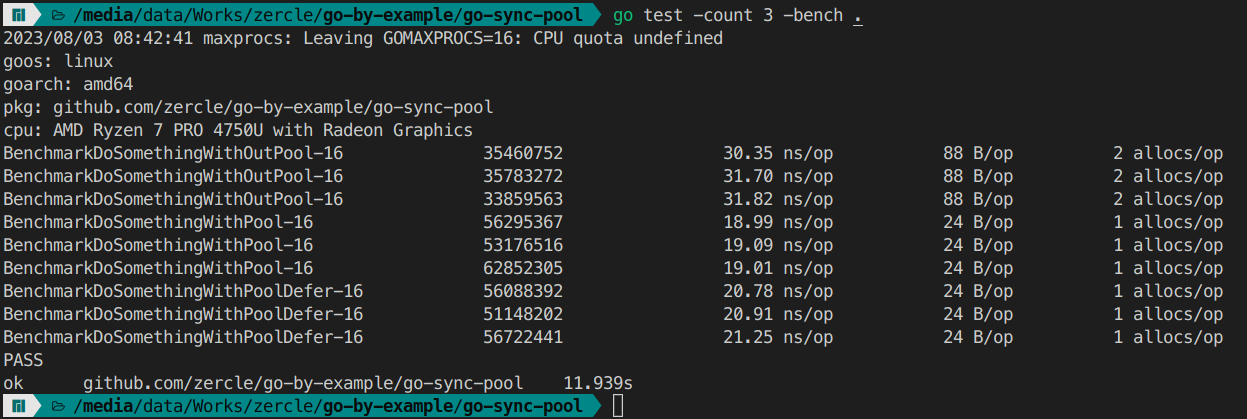Go and Reusing Memory with sync.Pool

If you’ve written goroutines, you’ve probably come across sync.WaitGroup for waiting on a group of goroutines. But in the sync package, there’s another useful type I’d like to introduce: sync.Pool, which helps reuse memory and reduce allocations for things that are used repeatedly.
How sync.Pool{} works
Let’s look at how sync.Pool{} works. The pool has two baskets: the Pool and the Victim, for caching before being cleared by the garbage collector (GC).
basic
Starting from nothing.
| Operation | Pool | Victim | caller | |
|---|---|---|---|---|
| 0 | 0 |
Getting from an empty Pool will allocate a new one.
| Operation | Pool | Victim | caller | |
|---|---|---|---|---|
| get | 0 | 0 | allocate | 1 |
Then put it back into the Pool.
| Operation | Pool | Victim | caller | |
|---|---|---|---|---|
| put | 1 | 0 | ← | 0 |
The next user will get from the existing Pool.
| Operation | Pool | Victim | caller | |
|---|---|---|---|---|
| get | 0 | 0 | → | 1 |
garbage collector
Before the garbage collector, everything is in the Pool.
| Operation | Pool | Victim | caller | |
|---|---|---|---|---|
| 3 | 0 |
After the garbage collector, it will be moved to the Victim.
| Operation | Pool | Victim | caller | |
|---|---|---|---|---|
| GC | 0 | 3 |
If there is a get after the garbage collector, it will be taken from the Victim.
| Operation | Pool | Victim | caller | |
|---|---|---|---|---|
| get | 0 | 2 | → | 1 |
When putting it back into the Pool.
| Operation | Pool | Victim | caller | |
|---|---|---|---|---|
| put | 1 | 2 | ← | 0 |
After another garbage collector cycle, what’s left in the Victim will be cleared out. What’s in the Pool will wait in the Victim, and so on.
| Operation | Pool | Victim | caller | |
|---|---|---|---|---|
| GC | 0 | 1 |
The structure of sync.Pool
This example is adapted from sync example-Pool. DoSomethingWithOutPool is the traditional way without using a pool. DoSomethingWithPool uses a pool by putting it back into the pool after use. DoSomethingWithPoolDefer uses a pool by deferring putting it back into the pool after the function ends.
var bufPool = sync.Pool{
New: func() any {
// The Pool's New function should generally only return pointer
// types, since a pointer can be put into the return interface
// value without an allocation:
return new(bytes.Buffer)
},
}
// timeNow is a fake version of time.Now for tests.
func timeNow() time.Time {
return time.Unix(1690909200, 0)
}
func DoSomethingWithOutPool() {
buff := new(bytes.Buffer)
// write to buffer
buff.WriteString(timeNow().UTC().Format(time.RFC3339))
// discard for test
io.Discard.Write(buff.Bytes())
// clear buffer before return
buff.Reset()
}
func DoSomethingWithPool() {
buff := bufPool.Get().(*bytes.Buffer)
// write to buffer
buff.WriteString(timeNow().UTC().Format(time.RFC3339))
// write from buffer to discard for test
io.Discard.Write(buff.Bytes())
// clear buffer before return to pool
buff.Reset()
bufPool.Put(buff)
}
func DoSomethingWithPoolDefer() {
buff := bufPool.Get().(*bytes.Buffer)
// clear buffer before return to pool after the end of function
defer func() {
buff.Reset()
bufPool.Put(buff)
}()
// write to buffer
buff.WriteString(timeNow().UTC().Format(time.RFC3339))
// write from buffer to discard for test
io.Discard.Write(buff.Bytes())
}
Comparing the results using (*testing.B).RunParallel to test in parallel.

Advantages
- Concurrently safe, so it can be used in goroutines at the same time.
- Saves memory allocation by borrowing from the cache in the pool.
Cautions
- Data in the pool is lost with each GC cycle (it’s not there forever).
- If you don’t
putit back into the pool, every time youget, a new instance will be created, making the overall system more wasteful (because it has to allocate more heap space). A middle ground is to usedefer putimmediately aftergetto help you not forget toputit back into the pool.
When should you use sync.Pool{}?
- As is typical for the sync package, use it in goroutines that repeatedly use the same methods so you don’t have to waste memory allocating every time you loop.
- Use it for tasks that have a high initialization cost and are used frequently, such as
parser,reader,writer,buffer,network connection, etc. (It’s like, it’s expensive to create, so I’ll just borrow it and return it when I’m done).- For example, ParserPool of valyala/fastjson